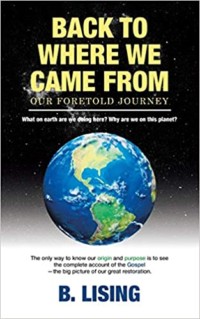Title: Back to Where We Came From: Our Foretold Journey
Author: B. Lising
Publisher: Partridge
ISBN: 978-1-5437-5788-0
Pages: 159 pages
Genre: Religious/Spiritual/Christian
Review by: CC Thomas
Pacific Book Review
Back to Where We Came From: Our Foretold Journey by B. Lising will certainly be unlike any religious book you’ve read before. While most Christian works are centered around tips and advice for how to live life or how to read the Scriptures, Lising instead focuses on more spiritual and esoteric matters. Lising explains that he has a belief in “the perfect consistency of Scripture” and that all books of the Bible really only hold one message, the same message. That message is found in the last book of the Bible, Revelation. While many are confused by or dismiss this book as rambling dreams or apocalyptic warnings, Lising advises the reader to take the book more serious. The word revelation literally means a fact that is revealed or made known or the communication of a divine truth. This, Lising insists, is exactly how readers and the faithful should view the book.
Lising doesn’t tiptoe into his perspectives, but instead dives headfirst into the murky waters of Biblical understanding by stating important questions, such as the origin of life, can be answered solely by Scriptural analysis. Furthermore, he advises that secular thought, and unseen forces of our modern world, enslaves us while a Christian perspective of our worldly predicament gives us freedom. In order to understand this, Lising insists it’s important to know the end game of New Jerusalem. He spends the rest of the book exactly laying out how this is so, with plenty of Biblical and Scriptural evidence to back up his claims.
So, how can a lay reader gain from understanding the author’s claims? Lising insists that the goal is love and friendship, in love. Having friends is the highest purpose in our lives, and, to prove this, Lising begins explaining three major prophetic discussions in the Gospel. The importance of understanding this is critical because the ultimate key is preparing for the second coming, what Lising refers to as New Jerusalem, the last stage in the faithful’s journey.
Lising also answers other questions that many have wondered about, but few have probably verbalized aloud. For example, why do we worship? For many, it’s simply an ingrained habit or a tradition. However, Lising reminds the reader that worship is an example of God being in control and our acknowledgement of that. Indeed, according to Lising’s understanding, worship is human’s evidence that Scriptures supports the premise that every moment of our lives are preordained. Lising also discusses many symbolic prophecies in the book and explains them in a clear and direct way. Baptism is one example. Lising explains that baptism is actually a prophecy, the message that symbolizes that God’s promise is fulfilled.
In Back to where We Came From, Lising states he wrote the book as a prayer and hoped that its message might find a home. This isn’t a practical guide or one that Christians should use for life advice or solace in troubling times. Rather, it is for those who yearn to better understand the murky Scriptures and apply its hidden messages directly to their lives. For, according to Lising, truly understanding is the only way to achieve God’s direct purpose for us all.


